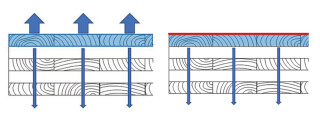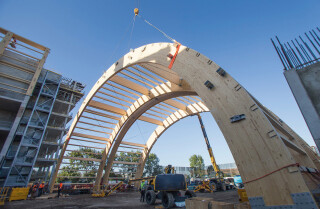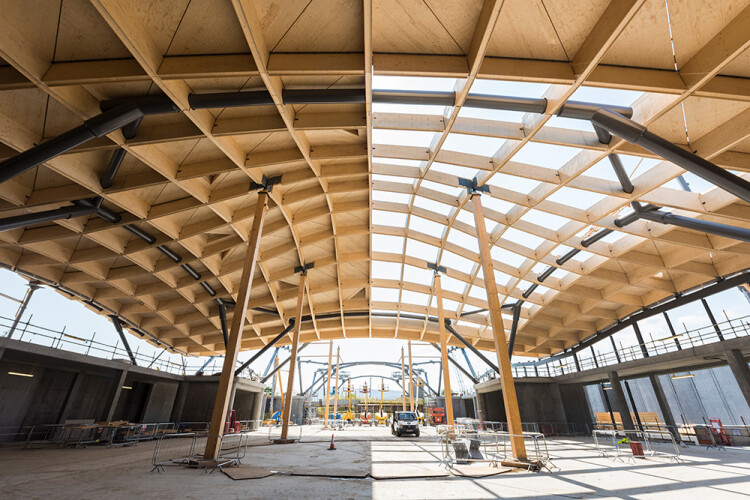Over the past 15 years there has been much talk about cross-laminated timber (CLT) and how this construction material has enabled designers to create taller, longer, wider and more elaborate timber buildings than had previously been possible.
CLT has also promised new and exciting opportunities for low-carbon – even ‘negative carbon’ – sustainable buildings. But, as with all timber, the effects of moisture can greatly compromise the performance and integrity of CLT.
Whether used to build small houses, medium-rise residential blocks, large educational buildings or even vast commercial office spaces, CLT has really taken off. As with all ‘new’ construction materials though, there has been a learning curve, with the industry’s understanding of CLT’s strengths and weaknesses evolving over time. One of the most common areas of debate with CLT is its durability, and in particular, how it is affected by moisture.
Providing timber and wood-based products are kept dry they will have an almost indefinite life expectancy – modern lightweight timber frame buildings have been used for nearly 100 years. Most of the UK’s housing stock has timber pitched roofs, many of which are centuries old. As a result, we now have a good understanding of how these lightweight timber structures, mostly made of relatively small cross-section sized timbers, behave and how to design and detail them to achieve a long service life.
And one thing we know is that, if its moisture content exceeds 20% for an extended period of time, timber is at risk of developing fungal decay. In a well-designed and constructed timber frame building or pitched roof, moisture content in service will be between 10% and 14% – well below the fungal decay threshold.
While CLT follows the same durability principles as lightweight timber structures, its thickness and the mass of timber used present additional considerations when exposed to moisture.

Timber studs, joists and rafters have a large surface-area relative to their volume. If they get wet, they will dry rapidly when conditions allow. On the other hand, CLT has a proportionately much smaller surface-area relative to volume and so drying rates can be substantially slower, which can seriously affect durability.
CLT external walls and roofs should always be designed as ‘warm’ constructions – in other words, all thermal insulation is placed on the outside face of the wall or roof panel. By placing the CLT panels within the thermal envelope of the building, panels are in what should normally be a warm and dry environment – ideal for timber durability.
In the UK, the most common insulation material to be placed on the outside of CLT has been rigid foil-faced insulation boards – for example, PIR/PUR/phenolic foam – installed to walls, flat roofs and pitched roofs. While these insulation materials have excellent thermal resistance and provide the necessary U-values for a given thickness, the foil facings limit the ability for the CLT panels behind to dry effectively.
Historically it was assumed that any wetting of the CLT panels (either through trapped construction moisture, cladding leaks or water ingress in service) would be able to dry through the panel to the inside of the building.
BM TRADA, the timber industry certification and accreditation body, has been undertaking research work on moisture dynamics in CLT with Finnish group Stora Enso, a leading global supplier of wood products including CLT. The two-part project looked at both wetting risk during construction and drying rates and has enabled us to determine moisture distribution behaviour.
In the second phase of the research, the drying rates of five-layer, 100mm-thick CLT panels were investigated. Various configurations were tested, including covering the wet outer face of panels with foil to replicate panels covered with rigid foil-faced insulation boards and/or vapour control layers. This test set-up was intended to replicate typical UK construction build-ups for warm walls as well as flat and pitched roofs.

During testing of the covered panels, water in the wet outside face lamination was observed slowly passing through the thickness of the panels to the dry uncovered side, confirming the previously held assertion that panels could dry to the inside.
However, with a starting moisture content of 35% in the wet outer lamination, it took almost 16 months for the moisture content to fall to 20%. With higher moisture contents and thicker panels, drying could potentially take years.
Conversely, uncovered panels that were able to dry directly from the wet face took approximately six weeks for a similar moisture content reduction.
A primary consideration to achieve long-term durability of timber structures is to provide a combination of drainage, ventilation and breathability. It is not normally an issue if timber gets wet, providing water can drain away quickly and the timber is subsequently allowed to dry.
Slowing down or restricting drying through the use of high resistance insulation products or vapour control layers on the inner or outer faces of the panels can slow drying to an extent that the development of fungal decay may become a risk if panels are subjected to adverse conditions during construction or in service.
Elsewhere in Europe, CLT building systems are often paired with mineral wool or wood-fibre insulation products. These breathable insulation materials are beneficial to timber building systems as they allow more rapid drying of the CLT panels if they are exposed to wetting during construction or in service. The use of breathable insulation products and systems, in conjunction with good overall design detailing and a moisture management plan for the construction phase, will have a significant positive impact on the long-term durability and robustness of CLT structures.
As the construction industry continues to move toward more sustainable processes, CLT will no doubt play its part in creating greener, low carbon buildings. But to ensure these structures are successful it’s vital that, across the sector, there is an understanding of how to protect CLT from moisture during construction.
.png)
CLT does invariably get wet while building works take place, in which case there needs to be sufficient time allowed for it to dry to an appropriate level, otherwise there is an increased chance of fungal and structural decay.
• Phil O’Leary is technical manager at BM TRADA
Concrete industry challenges CLT’s green credentials
While BM Trada celebrates the growing popularity of cross-laminated timber in construction, other vested interests are aggressively highlighting the material’s perceived shortcomings.
A recent report from the British Association of Reinforcement (BAR) says that CLT is ‘a chemical cocktail’ that is both flammable and environmentally damaging.
The report, entitled Is Cross Laminated Timber a potential Trojan Horse?, suggests that specifiers should take a closer look at the claimed benefits of CLT.
Needless to say, BAR has a big axe to grind – it exists to champion the cause of reinforced concrete structures – so its report cannot be considered impartial.
The wood lobby dismissed the BAR report as “a desperate attempt to smear a sustainable construction material by those sectors which have a less than positive tale to tell about their environmental impact”.
One of the big selling-points for timber and timber products is the material’s sustainability. When mature trees are cut down, young samplings are planted in their place, starting the whole carbon-sequestration process all over again.
But the BAR report says that consideration should be given to the CO2 emissions resulting from timber harvesting and rotting tree stumps, the energy used for the industrial process to dry the timber and fabricate the CLT panels and the CO2 impact of timber transportation around the world.
It continues: “A major reason why harvesting forests for construction materials is not so green is the resultant monoculture of the industrial timber plantations that are planted as farmed replacements. Such plantations should not be viewed as forests. A plantation is a highly uniform monoculture geared to the production of a single raw material that replaces natural ecosystems and their rich biodiversity. Increased demand for CLT could well increase the prevalence of monoculture ‘green deserts’.
“Furthermore, whereas forests are recognised carbon sinks, the same should not be said of new forced plantations which, unlike forests allowed to regrow naturally, can actually be net emitters of carbon due to the disturbance to the soil and the degradation of the previous ecosystem.”
BAR chairman Stephen Elliott says: “When you consider the destructive harvesting, industrial manufacturing process, additional chemicals and monoculture plantations it may be that too much credit has been given to timber being a green material. Indeed, it may better to keep the ‘wood’ alive rather than cut it down and build with it.” He also reiterates the ‘thermal sink’ argument frequently cited to endorse the energy performance of heavy concrete structures:
“The embodied CO2 used to make the materials is estimated to be 10-20% of a building. The rest – 80-90% – results from its use and operation. CLT, compared to heavyweight concrete construction, has low thermal mass. This means it has limited ability to absorb heat and even out temperature fluctuations. Concrete’s heavyweight thermal mass can play an active role in reducing heating and air conditioning requirements. Lightweight construction is far more reliant on mechanical air conditioning.
“Air condition a CLT building and, over its lifetime, its operational CO2 emissions will far surpass any supposed initial embodied savings. Then there are all the additional finishes and materials to provide what concrete inherently provides. The lightweight structure’s need for additional fire proofing, flood resilience, sound insulation all come with additional CO2 impacts.”
Elliott adds: “Cross laminated timber is a relatively new construction material having only been developed in the 1990s. The jury should, therefore, be out on its long-term performance, just as the jury should also closely examine its so-called green credentials.”
Timber Development UK chief executive David Hopkins is having none of it. “This report from BAR really brings nothing new to the table other than a desperate attempt to smear a sustainable construction material by those sectors which have a less than positive tale to tell about their environmental impact,” he says.
“There are already fully verified environmental product declarations behind all timber construction products that consider the whole supply chain. This means the impacts of timber products are measured, assessed, and verified by independent experts from forest to factory to operational building – right through to the product’s end of life.
“The truth is that timber is a renewable material which comes from sustainably managed resources – growing throughout Europe – which absorbs and stores carbon and requires very low energy inputs to process into high-performance low-carbon construction products,” continues Hopkins.
“Concrete, on the other hand, requires materials such as sand – produced from dredging rivers and seabeds, destroying ecosystems and habitats in the process – and huge inputs of energy and water to manufacture. It’s a very high carbon material and an issue that must be tackled to decarbonise construction.
“Rather than a constructive attempt to find solutions to the climate crisis, they would rather waste time dreaming up strawman arguments like this report because they know they cannot compete in a market with a greater focus on sustainability.”
Citing a recent academic paper in the Buildings & Cities journal, Hopkins concludes: “With the concrete industry having been called out for the inaccuracy of their messaging on carbon [in May 2022] they should instead focus their time on writing a realistic net-zero road map – rather than one based on wishful thinking, rhetoric, and the use of carbon capture and storage technologies which do not exist.”
Decide for yourself:
• Download a copy of Is cross laminated timber construction a Trojan Horse? At bit.ly/3HCy3J4
• The Buildings & Cities paper is at bit.ly/3Hhhcx7
Got a story? Email news@theconstructionindex.co.uk



